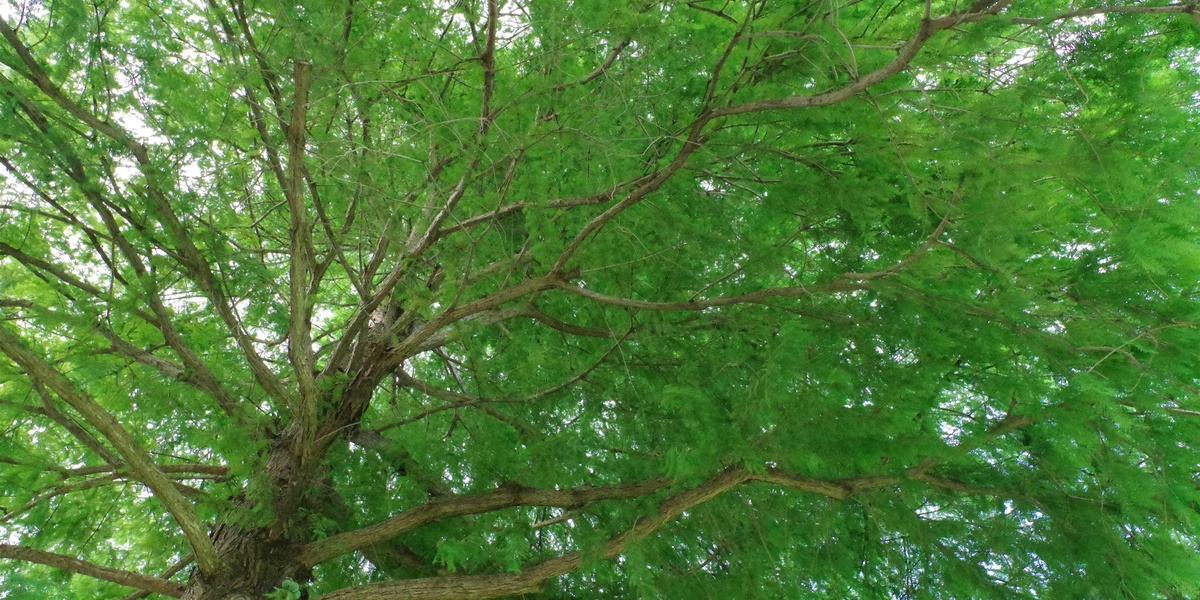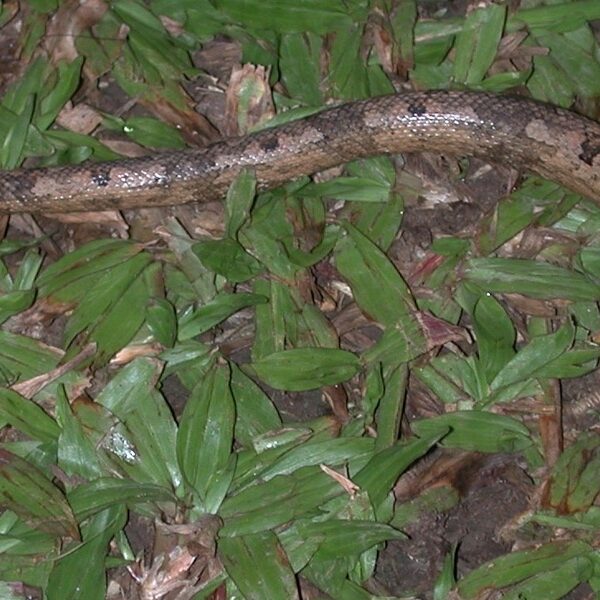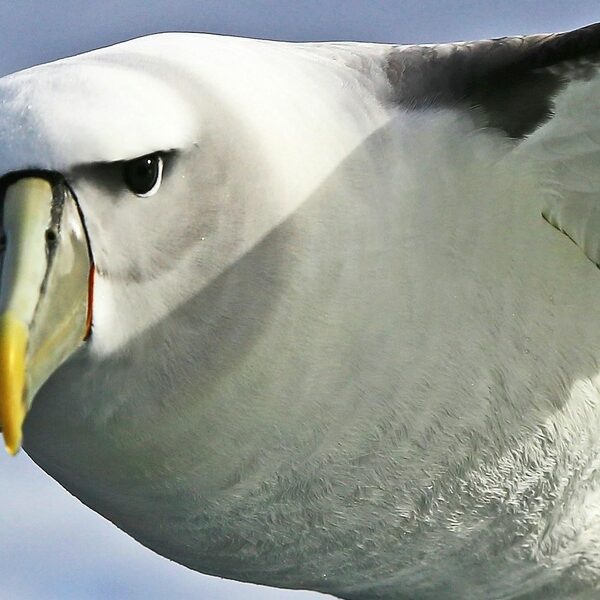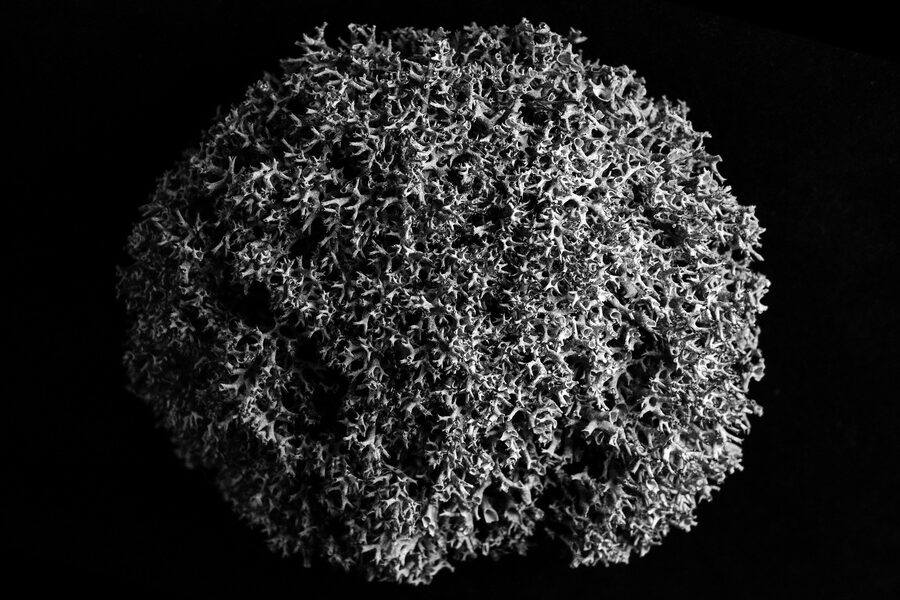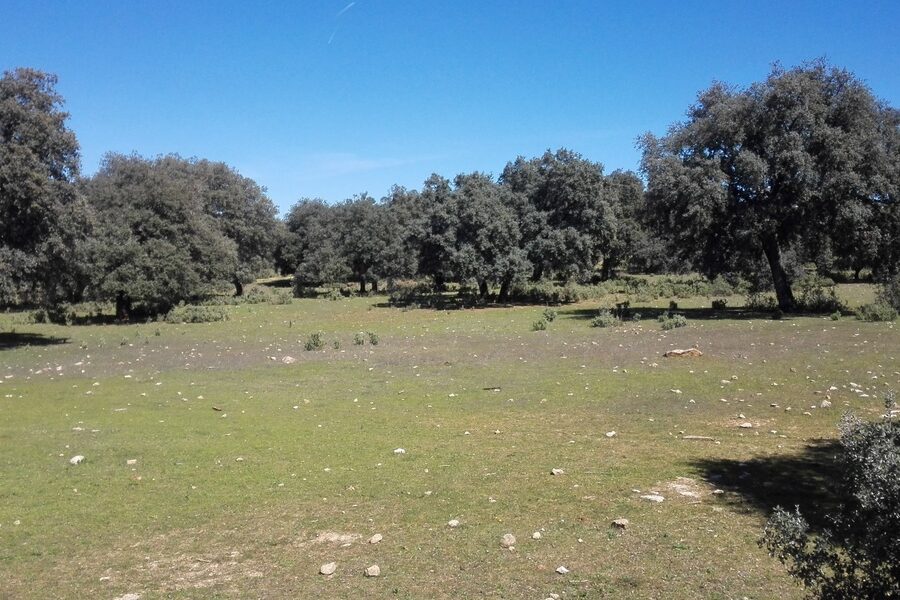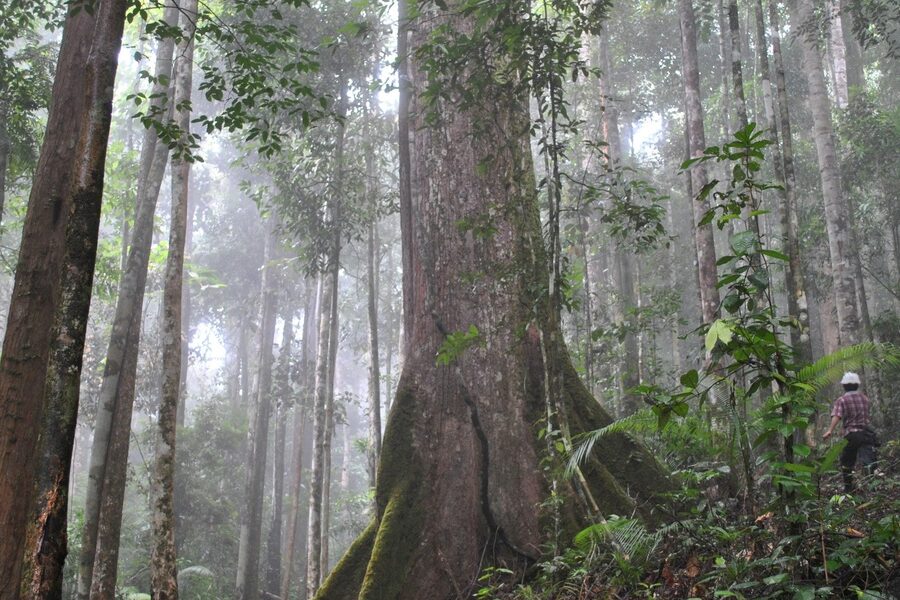Guyana’s landscapes shift quickly from coastal wetlands to dense inland rainforest and tepuis, so the trees you see can change with the terrain and season. Local communities, researchers and visitors all rely on simple field information to recognize species and understand where they belong in the landscape.
There are 36 Trees of Guyana, ranging from Backlit / Floodplain specialist to White mangrove. For each entry, data are organized as Scientific name,Height (m),Habitat / range in Guyana, and you’ll find those details below.
How were these 36 species selected?
The list focuses on species that are common, ecologically important or distinctive within Guyana’s major habitats (coastal wetlands, lowland rainforest, savanna and floodplain). Selection draws on field guides, herbarium records and regional checklists to balance familiar trees with those that indicate specific environments.
How should I use the Scientific name,Height (m),Habitat / range in Guyana columns when out in the field?
Use the scientific name to confirm identifications across languages, the height to get a quick sense of growth form and canopy role, and the habitat/range note to narrow where you might encounter a species—together they speed up locating and verifying trees during walks or surveys.
Trees of Guyana
| Common name | Scientific name | Height (m) | Habitat / range in Guyana |
|---|---|---|---|
| Greenheart | Chlorocardium rodiei | 30-45 | Lowland rainforest; common in central and interior forests |
| Mora (Mora) | Mora excelsa | 30-40 | Well-drained lowland and seasonally flooded forests; widespread on coastal plains and interior |
| Mora gonggrijpii | Mora gonggrijpii | 25-35 | Lowland evergreen forest and riverbanks across interior Guyana |
| Purpleheart | Peltogyne venosa | 20-35 | Lowland rainforest in interior regions, often on well-drained soils |
| Wallaba | Eperua falcata | 20-30 | White-sand and coastal plateau forests; common in Guiana Shield regions |
| Brazil nut | Bertholletia excelsa | 30-50 | Non-flooded terra firme forests in central and southern Guyana |
| Bigleaf mahogany | Swietenia macrophylla | 30-60 | Lowland and submontane rainforests in interior Guyana |
| Spanish cedar | Cedrela odorata | 20-30 | Secondary forest edges, well-drained inland forests |
| Bulletwood / Balatá | Manilkara bidentata | 20-35 | Upland and lowland rainforests across Guyana |
| Tonka bean | Dipteryx odorata | 20-35 | Non-flooded forests and river terraces in interior regions |
| Jatoba / West Indian locust | Hymenaea courbaril | 15-30 | Seasonally dry forest patches and lowland rainforests |
| Crabwood / Andiroba | Carapa guianensis | 20-35 | Riverbanks, floodplains and moist lowland forests throughout Guyana |
| Virola | Virola surinamensis | 25-40 | Alluvial and swampy forests, riverbanks across interior Guyana |
| Kapok | Ceiba pentandra | 30-60 | Riverine forest margins, secondary forest and savanna edges |
| Cow tree | Brosimum utile | 20-35 | Lowland humid forests and gallery forests in interior regions |
| Monkey-pot | Lecythis zabucajo | 20-35 | Non-flooded lowland rainforests in interior Guyana |
| Sapucaia / Couratari | Couratari guianensis | 30-45 | Terra firme forests and ridges across Guyana |
| Cannonball tree | Couroupita guianensis | 15-25 | Occasional in wild and near settlements; native to Amazonian region |
| Red mangrove | Rhizophora mangle | 5-25 | Coastal mangroves, river mouths and estuaries along Guyana’s coast |
| Black mangrove | Avicennia germinans | 3-15 | Upper mangrove zones and tidal flats along the coast |
| White mangrove | Laguncularia racemosa | 3-12 | Interior mangrove fringe and brackish waterways on the coast |
| Buttonwood | Conocarpus erectus | 3-12 | Coastal fringes, tidal lagoons and estuaries in Guyana |
| Ice-cream bean | Inga edulis | 8-20 | Riverbanks, forest edges and disturbed areas; common near settlements and trails |
| Hog plum | Spondias mombin | 6-15 | Savanna-forest edges, secondary growth and riverine areas in Guyana |
| Purpleheart (local trade) | Peltogyne spp. | 20-35 | Interior terra firme forests where selective logging occurs |
| Escheweilera / Wax tree | Eschweilera coriacea | 25-40 | Terra firme forests across interior Guyana |
| Nutmeg family (wild species) | Lecythidaceae species (local) | 20-40 | Non-flooded and riverine rainforests in interior Guyana |
| Palisandra / Mora-like | Eperua grandiflora | 15-30 | White-sand forests and lowland rainforests of the Guiana Shield |
| Pachira / Malabar chestnut | Pachira aquatica | 10-25 | River edges, seasonally flooded forests and disturbed moist sites |
| Brazilwood / Misc. timber | Anacardium excelsum (related species) | 20-35 | Riverine and lowland forests in interior regions |
| Sibipiruna / Local legumes | Pterocarpus officinalis | 15-30 | Swampy freshwater forests and river margins in Guyana |
| Burseraceae resin tree | Protium spruceanum | 15-30 | Terra firme and wet forests throughout Guyana |
| Sclerolobium / Local timber | Pachira insignis (synonym) | 15-25 | Riparian forests and lowland Amazonian habitats in Guyana |
| Gunung / Local emergents | Couratari spp. | 25-40 | Guiana Shield plateaus and terra firme forests |
| Backlit / Floodplain specialist | Pourouma cecropiifolia | 8-20 | Riverbanks and seasonally flooded forests in central Guyana |
| Tropical almond / naturalized | Terminalia catappa | 8-20 | Coastal towns, river edges and disturbed sites across Guyana |
Images and Descriptions
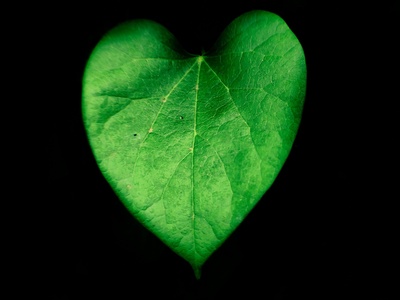
Greenheart
A massive emergent with very dense, greenish heartwood prized for marine and heavy construction. Look for smooth grey bark and buttresses; extremely durable timber, slow-growing and vital to Guyana’s commercial forestry and riverine habitats.
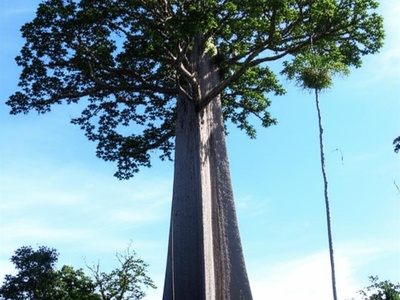
Mora (Mora)
Large, buttressed canopy trees forming monodominant stands on clay soils. Heavy, dark timber used for decking and river pilings; distinctive hard wood and persistent pods aid identification in Guyanese forests.
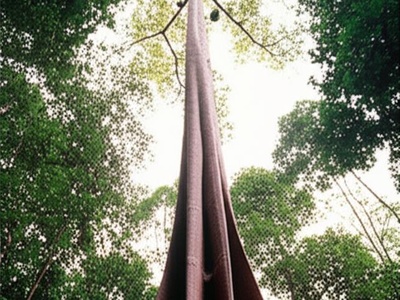
Mora gonggrijpii
Similar to M. excelsa but often in slightly different soils; tall, straight trunk with heavy timber prized locally. Produces large pods and is important for timber and wildlife habitat in Guyana’s rainforests.
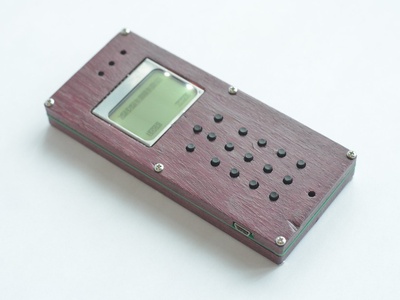
Purpleheart
Noted for vivid purple heartwood when cut, purpleheart is a mid-to-large canopy tree used for fine furniture and flooring. Smooth bark and compound leaves help identification; overharvesting has local conservation concerns.
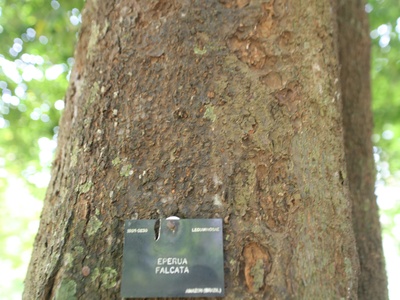
Wallaba
A tough, termite-resistant tree forming dense stands on poor soils. Recognizable by its shallow roots and hard wood; commonly used for local construction and known for persistence on nutrient-poor sites.
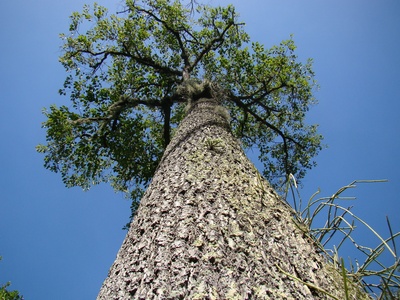
Brazil nut
Iconic giant producing edible nuts in large woody capsules; tall emergent with open crown. Economically important for wild-harvested nuts and forest livelihoods; requires intact forest for pollinators (large bees).
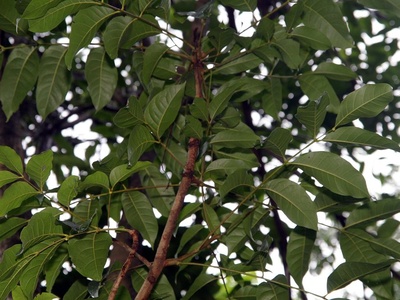
Bigleaf mahogany
Tall, buttressed tropical hardwood prized worldwide for furniture. Feathery pinnate leaves, winged seeds and chambered bark identify it; historically logged, now subject to conservation measures and CITES regulations in many regions.
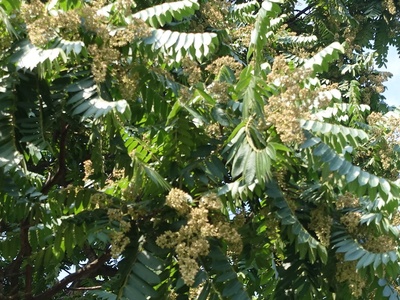
Spanish cedar
A medium-to-large timber tree with aromatic cedar wood used for cabinetry and cigar boxes. Compound leaves and winged fruits help identify it; responds to disturbance and is often found near human settlements in Guyana.
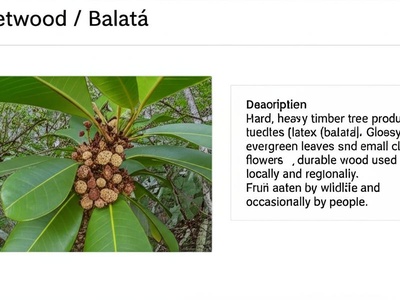
Bulletwood / Balatá
Hard, heavy timber tree producing latex (balatá). Glossy evergreen leaves and small clustered flowers; durable wood used locally and regionally. Fruit eaten by wildlife and occasionally by people.
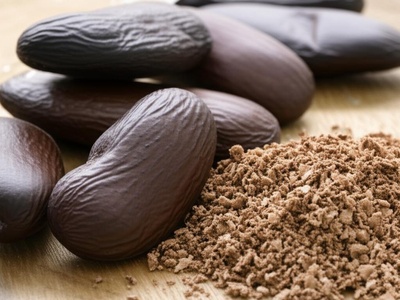
Tonka bean
A large tree with fragrant seeds (tonka beans) used as vanilla substitute and in perfumery. Dense timber and hard fruit pods; flowers attract pollinators and seeds are an important local trade item with fragrant scent when grated.

Jatoba / West Indian locust
A sturdy tree with hard, reddish timber and a sweet resin often called “copal.” It has showy flowers, large pods with sweet pulp and is used for timber, edible pulp and traditional medicines.
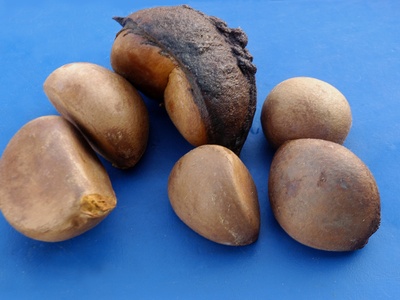
Crabwood / Andiroba
Recognizable by pinnate leaves and winged fruits; produces valuable oil used in traditional medicine and insect repellent. Wood is used locally, and the species is common in seasonally flooded riparian zones.
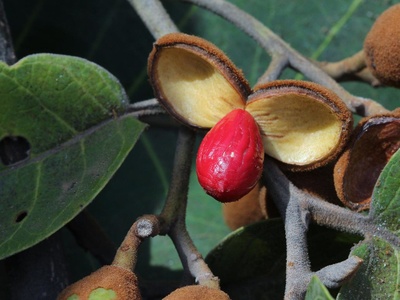
Virola
Large buttressed tree of the nutmeg family with reddish timber; some species produce aromatic bark and seeds used ritually. Important for timber and wildlife; often a canopy emergent in riparian forests.
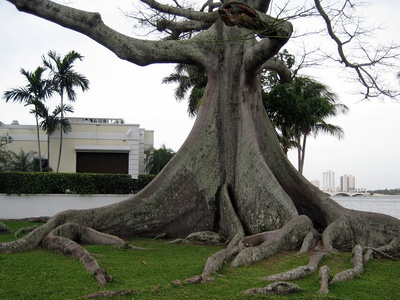
Kapok
A towering emergent with spiny trunk and large buttresses; produces silky kapok fiber in pods. Fluted trunk, palmate leaves and showy flowers; culturally significant and used for lightweight stuffing historically.
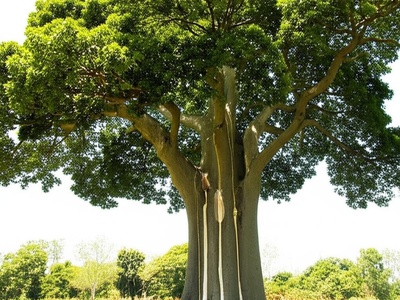
Cow tree
Known as the “cow tree” for its white latex historically used as milk substitute. Large tree with smooth bark and dense canopy; wood used locally and fruits eaten by wildlife and people.
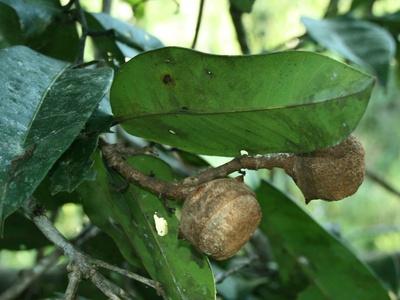
Monkey-pot
A tall tree in the Brazil-nut family with large woody “pot” fruits containing edible seeds. Showy, urn-shaped fruits and brush-like flowers; harvested locally and important for forest ecology.
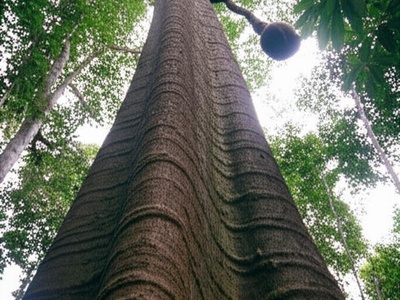
Sapucaia / Couratari
Emergent tree with large buttresses and urn-like seed capsules; heavy timber used locally. Tall, straight bole and leathery leaves make it a notable canopy species in Guyanese rainforests.
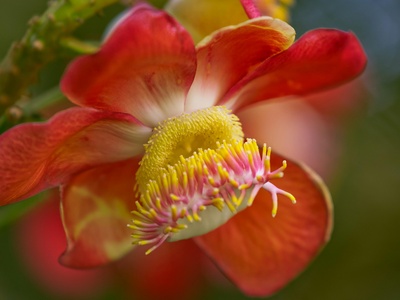
Cannonball tree
A striking tree with large spherical fruits and fragrant flowers; often planted near villages and temples. In Guyana it occurs naturally and is admired for its showy, fragrant blooms.
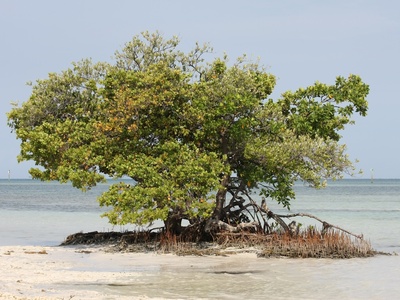
Red mangrove
A salt-tolerant tree with distinctive stilt roots and prop roots stabilizing shorelines. Easily identified by arching prop roots and viviparous seedlings; crucial for coastal protection, fisheries and biodiversity.
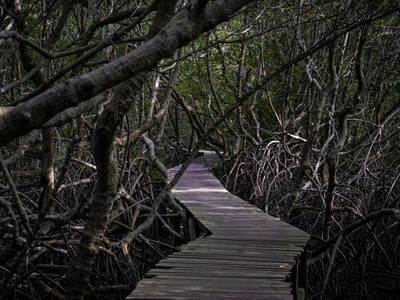
Black mangrove
A hardy mangrove with pneumatophores (breathing roots) and dark, furrowed bark. Salt excreting leaves and dense stands provide nursery habitat for fish and support coastal resilience in Guyana.
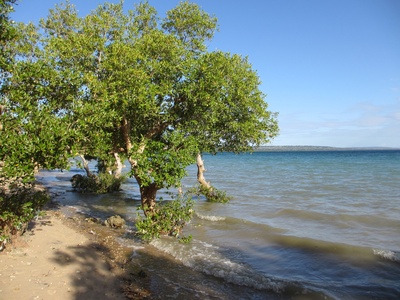
White mangrove
A small to medium mangrove tree occupying mid-mangrove zones with simple opposite leaves. Often found with black and red mangroves; useful for shoreline stabilization and local firewood.
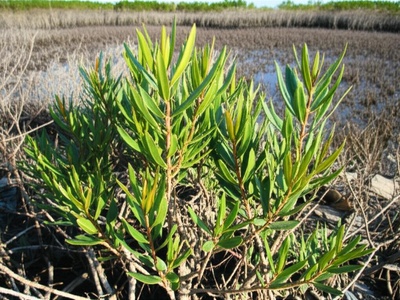
Buttonwood
A small, dense mangrove-associated tree with scaly bark and narrow leaves. Tolerates brackish conditions and is used locally for fuel and erosion control; often borders mangrove stands.
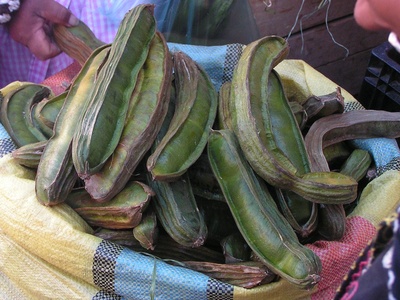
Ice-cream bean
Fast-growing leguminous tree with long pods filled with sweet, cottony pulp eaten fresh. Shade-providing and used in agroforestry; pinnate leaves and fragrant white flowers make it easy to spot.
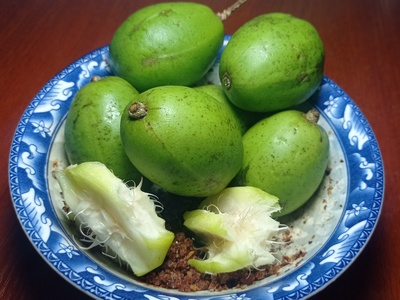
Hog plum
A small to medium tree with pinnate leaves and edible tart fruits used in jams and drinks. Adaptable species often seen in disturbed areas; birds disperse its fruits widely.

Purpleheart (local trade)
Member of a group known for deep purple heartwood used in fine woodworking. Stately canopy trees with compound leaves; harvesting has commercial value and conservation implications in Guyana.
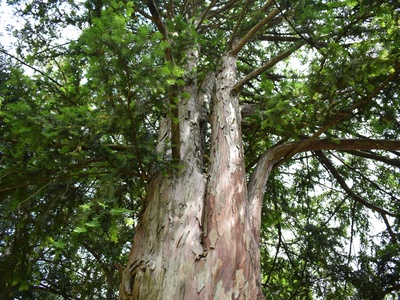
Escheweilera / Wax tree
Large evergreen canopy tree with leathery leaves and woody capsule fruits common in Guiana Shield forests. Dense timber and showy flowers attract wildlife; forms part of mature forest structure and biodiversity.
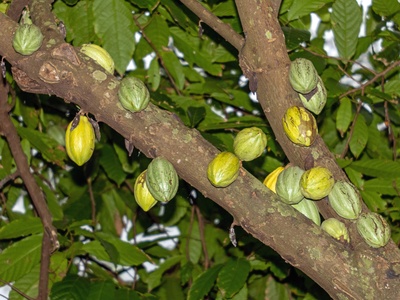
Nutmeg family (wild species)
Several large, canopy trees in the Brazil-nut family produce woody fruits and important seeds for wildlife and local use. Look for hard capsules, large buttresses and showy flowers in mature forests.
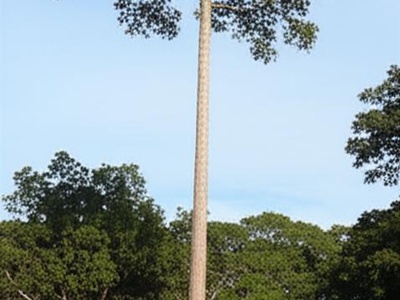
Palisandra / Mora-like
A durable timber species related to wallaba, often on nutrient-poor soils. Tall, straight trunks and compound leaves; used for local construction and notable for surviving poor edaphic conditions.
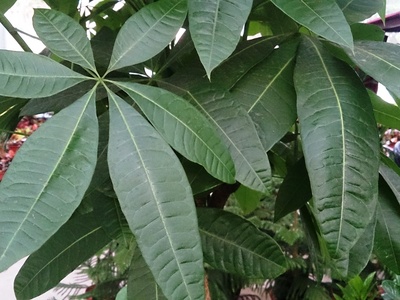
Pachira / Malabar chestnut
A medium tree producing edible nuts and large showy flowers; often found in swampy forest and riparian zones. Trunk sometimes swollen at base; fruit consumed locally and by wildlife.
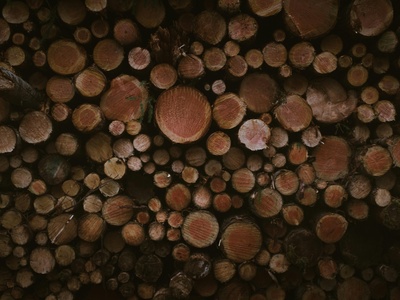
Brazilwood / Misc. timber
Tall tropical tree with spreading crown and edible fruits in some related species. Used locally for timber and shade; identifiable by compound leaves and distinctive fruiting structures.
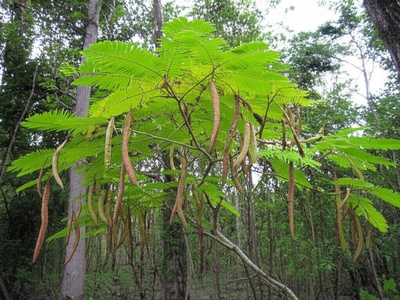
Sibipiruna / Local legumes
A nitrogen-fixing legume tree of flooded forests with compound leaves and papery pods. Wood used locally; often forms groves in seasonally inundated soils contributing to habitat complexity.

Burseraceae resin tree
A medium canopy tree producing fragrant resins (copal/elemi) used traditionally. Smooth bark and compound leaves; resins employed in folk medicine and ceremony, while species provide wildlife resources.
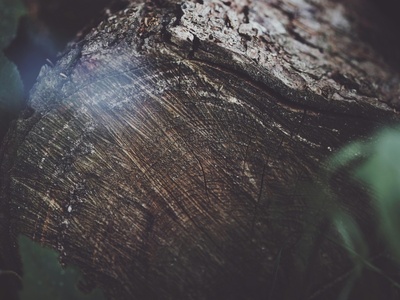
Sclerolobium / Local timber
A medium tree with edible seeds and durable wood, often used locally. Recognize by distinctive pods and palmate leaves; contributes to local diets and small-scale timber use.
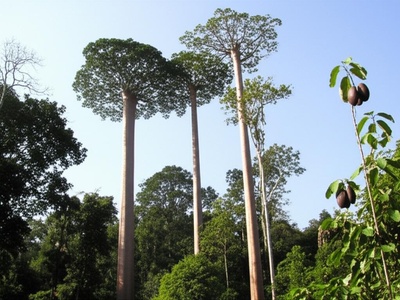
Gunung / Local emergents
Large emergent trees with buttresses and woody seed capsules; valued for timber and as keystone canopy species. Look for high crowns and leathery leaves typical of Lecythidaceae family members.
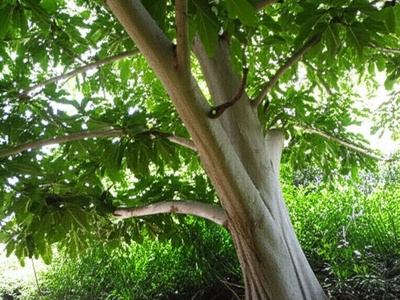
Backlit / Floodplain specialist
A fruit-bearing tree producing edible figs with sweet pulp; smooth bark and large simple leaves distinguish it. Common along waterways and used locally for food and shade.
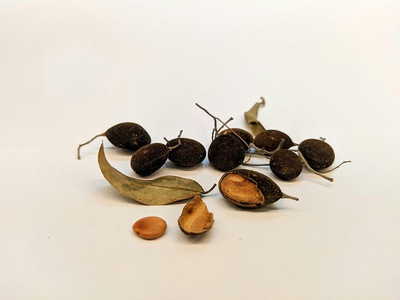
Tropical almond / naturalized
Often planted and now naturalized, this broad-crowned tree drops large, edible almond-like fruits. Distinctive layered branching and autumn leaf color; used for shade, ornament and food near coasts.
